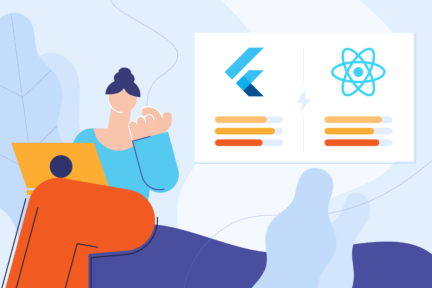

Cross-Platform App Development Explained
What is Cross-Platform App Development?
Cross-platform app development is the process of creating mobile or desktop applications that can run on multiple operating systems using a single codebase. Instead of writing separate code for each platform (like Android, iOS, or Windows), developers can write the code once and deploy the app on various platforms, saving time and resources. This approach contrasts with native app development, where developers create platform-specific versions of the same app.
Key Concepts of Cross-Platform App Development:
- Single Codebase: The hallmark of cross-platform development is a single codebase that can be compiled and run across different platforms. This drastically reduces the amount of work needed to maintain and update apps, since changes only need to be made once.
- Frameworks and Tools: Cross-platform app development typically involves using a development framework or tool that abstracts the differences between platforms. Popular frameworks include Flutter, React Native, and Xamarin. These frameworks allow developers to write code in a common programming language (such as Dart, JavaScript, or C#) and handle the platform-specific details behind the scenes.
- Platform Independence: The goal of cross-platform development is to ensure that the app looks and behaves consistently across all platforms while taking advantage of each platform’s unique features when necessary.
Popular Cross-Platform Development Frameworks:
- Flutter: Created by Google, Flutter uses the Dart programming language and allows developers to build natively compiled applications for mobile, web, and desktop from a single codebase. It focuses on high-performance apps with custom designs.
- React Native: Developed by Facebook, React Native uses JavaScript and React to create cross-platform mobile apps. It allows developers to share code between iOS and Android while using native components for a more seamless experience.
- Xamarin: Owned by Microsoft, Xamarin uses C# and .NET to build mobile apps that can run on both Android and iOS. Xamarin allows for deep integration with native APIs, providing access to platform-specific functionality.
- Ionic: A hybrid app development framework that uses web technologies (HTML, CSS, JavaScript) and Angular to build cross-platform apps. It relies on web views for rendering but can access native device features via Capacitor or Cordova.
For more information and detailed comparison, check our article on the best cross-platform app development frameworks.
Benefits of Cross-Platform App Development:
- Cost-Effective: Since developers only need to write code once, it saves development costs as compared to building separate native apps for different platforms.
- Faster Development: A single codebase means developers can deploy an app on multiple platforms simultaneously, reducing time to market.
- Code Reusability: With cross-platform frameworks, a large portion of the code can be reused across different platforms, enhancing efficiency.
- Consistent UI/UX: Cross-platform frameworks allow for consistent design and functionality across platforms, ensuring that users have a uniform experience, regardless of whether they use iOS, Android, or another platform.
- Easy Maintenance: Because the code is centralized, updates and bug fixes can be applied once and rolled out across all platforms, simplifying maintenance.
Challenges of Cross-Platform App Development:
- Performance Issues: Cross-platform apps may not always perform as smoothly as native apps, especially for graphics-intensive tasks or when interacting with platform-specific hardware. However, frameworks like Flutter have significantly improved performance with native-like experiences.
- Limited Access to Native Features: Some cross-platform tools may have limited access to platform-specific features or require additional workarounds to use advanced native APIs (though Flutter and React Native both allow native code to be embedded when necessary).
- Platform-Specific Bugs: Since cross-platform apps are designed to run on multiple operating systems, platform-specific bugs or behavior inconsistencies can sometimes arise, requiring additional troubleshooting.
- Customization: While cross-platform development ensures a shared codebase, achieving platform-specific customizations may require extra effort, especially if you want to adhere closely to the UI/UX guidelines of each platform (e.g., iOS’s Human Interface Guidelines or Android’s Material Design).
Use Cases for Cross-Platform Development:
- Business Apps: Companies building internal tools or customer-facing apps often choose cross-platform development to save on costs and reduce time to market.
- E-Commerce: Cross-platform development is ideal for e-commerce apps that need to maintain consistency across multiple devices while handling large volumes of users.
- Social Media Apps: Social media apps that need to run on both Android and iOS with frequent updates and interactive features benefit from the fast iteration times offered by cross-platform frameworks.
- Startups: Startups with limited budgets and time constraints often prefer cross-platform development because it allows them to launch on multiple platforms simultaneously with minimal investment.
Practical Example of Cross-Platform App Development:
Suppose a business wants to build a mobile app for both Android and iOS. Instead of hiring separate teams to build native apps in Kotlin (for Android) and Swift (for iOS), they can choose a cross-platform framework like Flutter. The developers would write the code once in Dart and then compile it into apps for both Android and iOS. This not only saves time but ensures consistency across both platforms.
Conclusion:
Cross-platform app development is a powerful approach for creating mobile, web, and desktop applications that can run on multiple operating systems using a single codebase. It reduces development time, cost, and complexity while still delivering apps that work seamlessly on different platforms. Cross-platform app development is becoming increasingly popular, making it a go-to solution for businesses and developers alike.
Ready to discover more terms?





